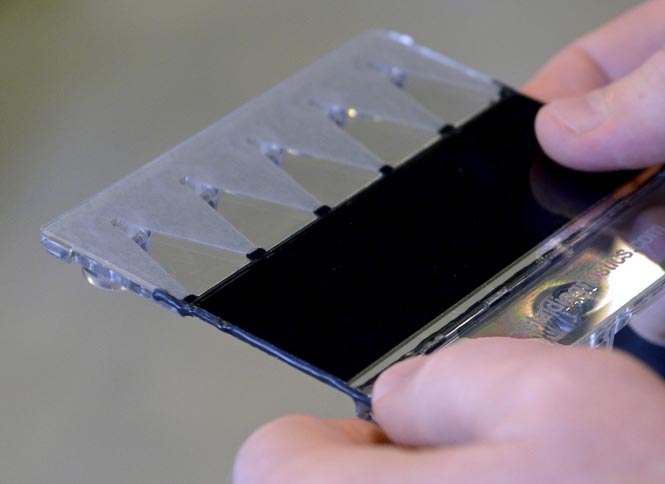New technology will improve food pathogen testing
The Liquid Crystal Department unveiled the new MultiPath system Oct. 26. Users place food samples inside of the small cups, connect it with a computer and the system tests for E. Coli and Listeria. The black strips change color if there is contamination. Photo by LAURA FONG
October 27, 2011
Crystal Diagnostics revealed new technology Wednesday at Kent State Centennial Research Park that allows scientists to more accurately test food for multiple pathogens in the time it takes to watch “The Office.”
“This technology can detect multiple pathogens within 30 minutes,” said Crystal Diagnostics CEO Paul Repetto. “There is no other technology available that allows a food processor to do that. It is unique.”
Every year food-borne pathogens cause an estimated 48 million illnesses, 128,000 hospitalizations and 3,000 deaths, according to a press release from Crystal Diagnostics.
The new Multipath system was designed to improve the accuracy and speed of food-pathogen testing.
The system is composed of a two parts, a glass “cassette” and a “reader.” Samples are placed in the cassette’s chambers and then placed in the reader. If a sample is contaminated with a pathogen, the liquid crystals in the reader will disrupt.
#KWcrystal
new TWTR.Widget({
version: 2,
type: ‘search’,
search: ‘#KWcrystal’,
interval: 6000,
subject: ”,
width: 240,
height: 300,
theme: {
shell: {
background: ‘#b8b8b8’,
color: ‘#66a9c5’
},
tweets: {
background: ‘#b8b8b8’,
color: ‘#444444’,
links: ‘#1985b5’
}
},
features: {
scrollbar: true,
loop: true,
live: true,
hashtags: true,
timestamp: true,
avatars: true,
toptweets: true,
behavior: ‘default’
}
}).render().start();
The new system has several benefits, including the ability to detect multiple pathogens like Salmonella, Listeria and E. coli in a single test while assuring more accurate results through the use of antibodies.
The system’s connectivity also allows the technician to connect the reader to an iPad, PC or smart phone, allowing the user to recall test data any time or place.
The Multipath System is set to commence sales to the food industry in 2012 after undergoing a few more rounds of beta testing with major food producers.
Chris Woolverton, Kent State researcher and co-patent holder, said the system is ready for use but it will depend on the user’s intentions.
“(Food industries) just want to see accuracy and consistency,” he said. “Once it’s licensed by the FDA, EPA, etc… it’s like the ‘Good Housekeeping’ seal of approval.”
The Multipath System was developed jointly by a research partnership between Kent State and Northeast Ohio Medical University (NEOMED).
Kent State President Lestor Lefton thanked researchers and staff at the unveiling for their hard work.
“We’re experiencing a breakthrough; what we do matters,” Lefton said. “It promises to save lives, and what could be more important than that?”
Contact John Milligan at [email protected].

























